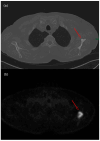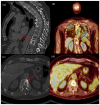Merkel Cell Carcinoma: An Updated Review Focused on Bone and Bone Marrow Metastases
- PMID: 40647550
- PMCID: PMC12248508
- DOI: 10.3390/cancers17132253
Merkel Cell Carcinoma: An Updated Review Focused on Bone and Bone Marrow Metastases
Abstract
Background/objectives: Despite advancements in early diagnosis and clinical practices guided by standardized care protocols, Merkel cell carcinoma (MCC) is marked by an unfavorable prognosis with a 5-year relative survival rate of 65%, based primarily on data collected prior to the introduction of immunotherapy. Regional nodal metastases affect 40-50% of MCC patients, while approximately 33% experience distant dissemination. Among these, bone and bone marrow metastases are particularly notable, although the characteristics and clinical implications of this metastatic disease in MCC remain poorly understood.
Methods: A comprehensive review was conducted using the Medline database (via PubMed) up to January 2025. The search strategy included the string "(Merkel cell carcinoma AND (bone OR marrow))".
Results: A total of 1133 (69.3% male and 30.7% female) patients diagnosed with advanced MCC were collected. The median (IQR) age at diagnosis was 67.5 (12.65) years old. Overall, 201 (20.8%) cases of bone and/or bone marrow metastases were identified and linked to a primary known MCC in 75.7% of cases. Bone metastases (BMs) appear as the third most common metastatic site, following the liver (second) and lymph nodes (first). They show mixed biological and radiological behavior, with a marked preference for the axial skeleton over the appendicular one. Addressing the characteristics of metastatic bone disease, neurological symptoms were the most documented, whereas bone marrow involvement and leukemic spread seemed to be primarily related to immunosuppression. Multimodal treatment strategies, including platinum-based chemotherapy and radiotherapy, were the primary approaches adopted, reflecting therapeutic practices from the pre-immunotherapy era.
Conclusions: The pattern of metastatic spread in MCC differs among studies, with the bones resulting as the third most common site of distant spread. Excluding head and neck MCC, which seems to be more regularly associated with liver metastases, the relationship between the primary tumor site and the development of bone or bone marrow metastases appears inconsistent. Overall, BMs mostly correlated with advanced MCC stages and poorer survival outcomes, with a median overall survival (OS) of 8 months (range 12.75-4). The integration of international guidelines, evolving evidence from clinical trials, and the expanding role of immune checkpoint inhibitors (ICIs) will contribute to improving systemic disease control and enhance patient care.
Keywords: MCC; MCCUP; Merkel cell carcinoma; RCM; bone; bone marrow; dermoscopy; diagnosis; etiology; metastasis; origin; radiotherapy; reflectance confocal microscopy; therapy; treatment.
Conflict of interest statement
The authors declare no conflicts of interest.
Figures









References
-
- Lugowska I., Becker J.C., Ascierto P.A., Veness M., Blom A., Lebbe C., Migliano E., Hamming-Vrieze O., Goebeler M., Kneitz H., et al. Merkel cell carcinoma: ESMO-EURACAN Clinical Practice Guideline for diagnosis, treatment and follow-up. ESMO Open. 2024;9:102977. doi: 10.1016/j.esmoop.2024.102977. - DOI - PMC - PubMed
-
- Gauci M.L., Aristei C., Becker J.C., Blom A., Bataille V., Dreno B., Del Marmol V., Forsea A.M., Fargnoli M.C., Grob J.J., et al. Diagnosis and treatment of Merkel cell carcinoma: European consensus-based interdisciplinary guideline—Update 2022. Eur. J. Cancer. 2022;171:203–231. doi: 10.1016/j.ejca.2022.03.043. - DOI - PubMed
-
- SEER*Explorer: An Interactive Website for SEER Cancer Statistics. [(accessed on 23 December 2024)]; Surveillance Research Program, National Cancer Institute. Available online: https://seer.cancer.gov/explorer/
Publication types
LinkOut - more resources
Full Text Sources

